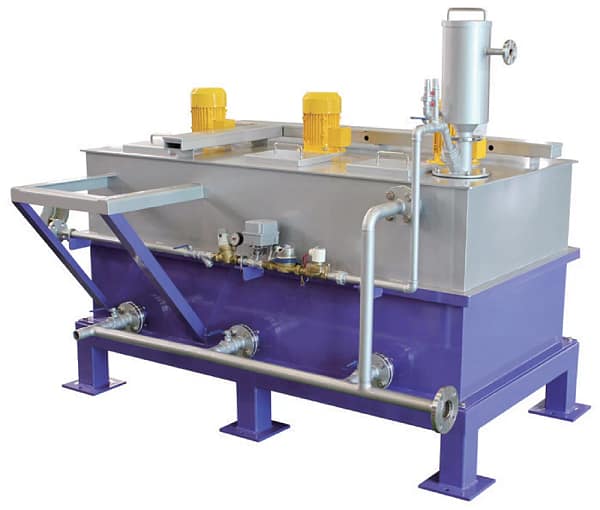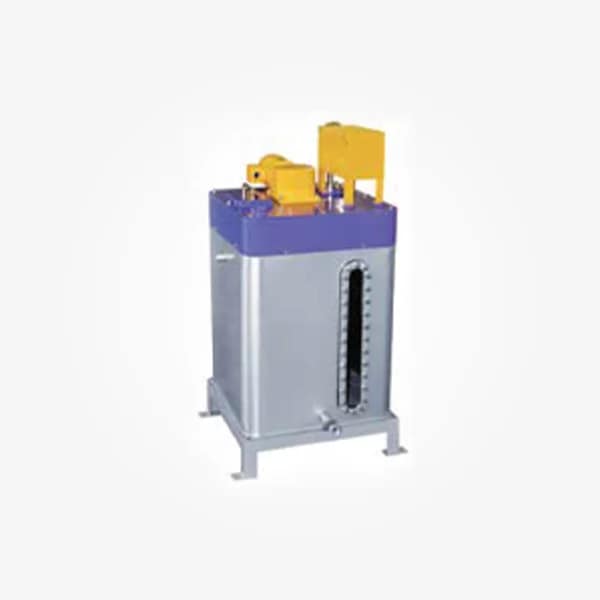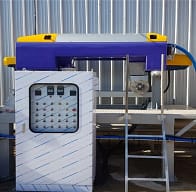
FREETA-α
| FTα-P/E-1 Specs | |
|---|---|
| Working volume | 1 m³ |
| Dimension | 1960 x 1000 x 750 mm |
| Motors | 1.1 kW ( 0.37 kW x 3 units ) |
| FTα-P/E-2 Specs | |
|---|---|
| Working volume | 2 m³ |
| Dimension | 2100 x 1100 x 1010 mm |
| Motors | 2.25 kW ( 0.75 kW x 3 units ) |
| FTα-P/E-3 Specs | |
|---|---|
| Working volume | 3 m³ |
| Dimension | 2440 x 1220 x 1200 mm |
| Motors | 2.25 kW ( 0.75 kW x 3 units ) |
| FTα-P/E-4 Specs | |
|---|---|
| Working volume | 4 m³ |
| Dimension | 2580 x 1490 x 1230 mm |
| Motors | 2.25 kW ( 0.75 kW x 3 units ) |
| FTα-P/E-5 Specs | |
|---|---|
| Working volume | 5 m³ |
| Dimension | 2580 x 1490 x 1230 mm |
| Motors | 2.25 kW ( 0.75 kW x 3 units ) |
| FTα-P/E-6 Specs | |
|---|---|
| Working volume | 6 m³ |
| Dimension | 3048 x 1524 x 1230 mm |
| Motors | 2.25 kW ( 0.75 kW x 3 units ) |
| FTα-P/E-7 Specs | |
|---|---|
| Working volume | 8 m³ |
| Dimension | 3920 x 1524 x 1230 mm |
| Motors | 4.50 kW ( 1.50 kW x 3 units ) |
| FTα-P/E-8 Specs | |
|---|---|
| Working volume | 10 m³ |
| Dimension | 3440 x 2240 x 1230 mm |
| Motors | 4.50 kW ( 1.50 kW x 3 units ) |
This is the 3D model of the decanter centrifuge researched and developed by ARK R&D Team engineers. It helps customers clearly visualize the details of each component, such as the centrifugal chamber, screw, motor, and gearbox unit.
Optimal 3D Viewing Environment : PC (i5 or higher), Mobile (Android 7.0 or higher, or iOS 14.0 or higher)
💧 ARK Flocculant-dissolving System, FREETA-α Overview
| Flocculant-dissolving tank volume | Up to 8 m³ |
| Working volume | Adjustable to either 33%, 67% or 100% of the total volume of flocculant-dissolving tanks |
| Types of solutes | Powdered polymer flocculant |
| System | A powder feeder and three flocculant-dissolving tanks in series |
💧Reasons that you need to install the flocculant-dissolving system at your factories/treatment plants
The powdered polymer flocculants are one of the most widely used chemicals in the sludge dewatering processes. Unfortunately, the polymers are not quickly dissolved in water due to their long chain length. When the feeding rate of the chemicals to the water is too fast and/or in case of poor agitation, the powders may form masses (lumps), which results in a very slowed dissolution.
To attain a perfect dissolution of the powdered polymer flocculants in water, both a controlled agitation and a certain mixing time are essential. Since the polymers of the powder are present in a physically shrunk form, the macromolecules have to be expanded in water to maximize the flocculation effect. To allow the expansion, the polymer solution must be placed in the tank for 30-60 minutes, which is called maturation time.
The ARK’s Flocculant-dissolving System, FREETA-α, perfectly achieves the dissolution and maturation of the emulsion polymer flocculants in the dilution water.
💧Strong points of the ARK’s Flocculant-dissolving System, FREEAT-α
FREETA-α lineups are equipped with a set of agitators to not form masses (lumps) during the dissolution of the powdered polymer flocculants.
If the agitation is poor, the masses (lumps) are quickly formed, which are not dispersed in water. This results in overconsumption of the polymer flocculant in the sludge dewatering process.
The three tanks in series equipped with FREETA-α allow a perfect dissolution of the slowly soluble polymer flocculants.
🤝Customer-support services
You may utilize FREETA- α for conditioning any flocculant species in a desired concentration. Besides a powder form, both an emulsion form and a solution form may also be fed to the flocculant-dissolving tanks.
The powder feeder pushes the powdered polymer flocculant in the flocculant-dissolving tank at a predetermined feeding rate. In the flocculant-dissolving tanks in series, the powders are perfectly dissolved with the agitators. The product (polymer solution) does not have remaining masses (lumps) and is continuously produced from the system.
Yes. The hydraulic retention time over the three tanks in series has been designed to attain both perfect dissolution of polymer flocculants and their maturation.
Depending on the capacity of the existing flocculant-dissolving system, no expansion is necessary. Please inquire at ARK for further suggestions.
Brochure about ARK’s products
(in Korean language)

ARK News
(machine-translated)
-
Vietnam has been dubbed the ‘new dragon of Asia" due to its spectacular economic growth. But beneath the glittering growth are serious growing pains. Endless waste, polluted nature, and graying skies. The Vietnamese government has recognized the seriousness of the problem and has drawn the sword of the law, but with great change comes great opportunity. Right now, Vietnam's environmental problems are paradoxically [...].October 28, 2025
-
Vietnam Water Market Insights Source: Water & Sewerage / Overseas Construction Association Hyo Eun Kim Vietnam's spectacular economic growth is no secret. However, there is another reality behind this spectacular growth that we need to pay attention to. That is the issue of water infrastructure. Despite having abundant water resources, dilapidated water facilities that cannot keep up with the pace of rapid urbanization and industrialization are a challenge that Vietnam must address, and at the same time, a barrier to new business [...]October 30, 2025
-
My name is Seulgi Kim, Marketing Manager of ARK company. ARK is participating in the 3-day VIETNAM WATER WEEK exhibition. Vietnam Water Week 2025 is an international exhibition in the field of water supply, sewage, water purification, wastewater treatment and environmental sanitation, and is a well-established environmental exhibition in Vietnam. We will be showcasing our next-generation decanter centrifuge, which has been continuously improving its performance through ongoing research and development (R&D) projects to ensure outstanding efficiency, and will be attracting much attention [...]August 6, 2025
-
ARK Participation in Indonesia Water Treatment Expo! Hello, this is Seulgi Kim, ARK Korea Marketing Manager. ARK is participating in a water treatment fair in Indonesia. We would like to meet and greet with many representatives and companies related to sewage and wastewater treatment in Indonesia and explain our products. We are a product that has received the best rating as a ‘procurement superior product‘ certified by the Korean government, which is designed to meet the standards of advanced urban water treatment in Korea. We have entered the Indonesian water industry and [...]August 6, 2025
-
Review of NVEX 2025, Valuable time to meet decanter centrifuge and screw press buyers Our booth, which was visited by many people, was closely watched not only by buyers but also by representatives of related organizations such as the water cluster and the Korea Environment Agency. As a company belonging to the water industry cluster, we also participated in the exhibition with pride. Our booth, which was visited by many people, was observed not only by buyers, but also by representatives of related organizations such as the water cluster and the Korea Environment Agency. Let me introduce the companies whose booths attracted attention among the various companies. CJK (CJK) Website [...]June 17, 2025
-
Meet the future of innovative decanter centrifuge technology We invite you to the exhibition! Dear water industry stakeholders, RK, a leading innovator in the water industry, invites you to a special exhibition at COEX L-13 from Wednesday, June 11th to Friday, June 13th. At this exhibition, we will be exhibiting our highly efficient decanter centrifuges that incorporate our unique technology. Our decanter centrifuges, which will contribute to solving environmental problems and increasing resource efficiency, are already used in many industrial [...]August 10, 2025
-
https://www.loud.kr/contest/view/170083 👆👆👆 View the crowdsourcing contest (designer account required)👆👆👆 👆👆👆 Greetings - Why are you starting a project? Hello, we are a dehydrator development company. For those who work in the water industry, dehydrator is a common term, but for those who don't, it may be unfamiliar. We are a Korean company with a factory in Vietnam that develops various types of dehydrators, which are devices for dehydrating sewage and wastewater in the water industry. Currently, as a carbon reduction project, we are combining decanter centrifuges with FRP in addition to the existing stainless steel [...].August 10, 2025
-
Hello, dear RK family! 🎊 On the occasion of the Chinese New Year 2025, we would like to extend our heartfelt greetings to you. We would like to express our deepest gratitude to everyone who has been with us in the past year. Just like the dehydrator we developed for water treatment, we hope this year will be a year where the unnecessary things in your life are cleanly dehydrated and only the pure and valuable things remain. 💧✨ Chinese New Year is a holiday for sharing precious time with family and friends, and with the busy [...]...August 10, 2025
-
Dear Customers, Greetings from all of us at ARK on the occasion of the year 2025. The year 2024 was a year in which the Korean water industry made a significant leap forward. Overseas exports through the Korea Environment Agency's water cluster reached KRW 109.3 billion, a remarkable achievement, and the overall growth rate of the industry remained stable at 2.91 TP3T. In particular, as long as digital transformation accelerated across the water industry and eco-friendly solutions were actively developed to respond to climate change, [...]August 10, 2025
-
Hello, I'm Sohee Jeon, a public relations manager at ARK, and I'd like to share my experience of VIETWATER2024, which took place last week from the 6th to the 8th. Held at the Saigon Exhibition & Convention Center (SECC), it was a meaningful event that made us realize how deep and important the water industry is in Southeast Asia. Water is a food and energy resource that can sustain irreplaceable life energy called ‘WATERGY‘ in the future. On the other hand, after extreme weather events, we are affected by heavy rainfall flooding in an unpredictable short time. In this [...]August 10, 2025
-
Hello, this is RK. We are participating in the historic VIETWATER event. We will participate in VIETWATER 2024, Vietnam's largest water industry exhibition. VIETWATER is Vietnam's largest water industry exhibition, showcasing the latest solutions and products in water management, water treatment, and environmental technology. The annual event gathers companies and professionals from around the world to discuss sustainable water management, water recycling, wastewater treatment, and [...]August 10, 2025
-
[Going to the National Product Industry Cluster] [3] ’Overseas Performance Evaluation‘ Paves the Way for Chinese Companies to Export The National Product Industry Cluster is pioneering overseas sales for its resident SMEs through the ‘Overseas Performance Evaluation' program. It identifies companies that have excellent technology but have difficulties in developing overseas sales. It verifies product performance at the demonstration plant and provides the results to overseas customers to increase reliability and conduct 'third-party performance verification'. Water companies such as CJK and ARK were selected in 2022 and last year through open recruitment followed by expert evaluations, and [...]November 3, 2025
Categories
Brochure about ARK’s products
(in Korean language)


















